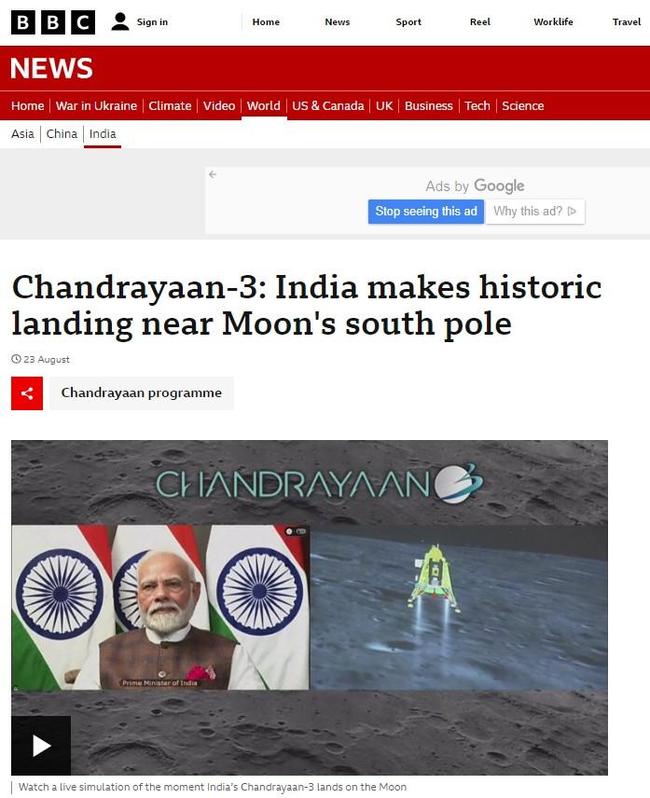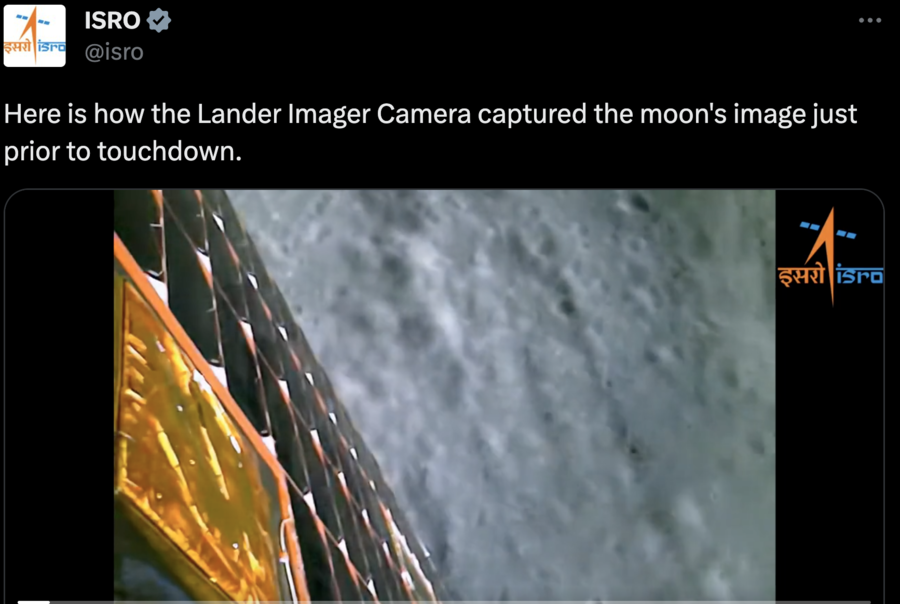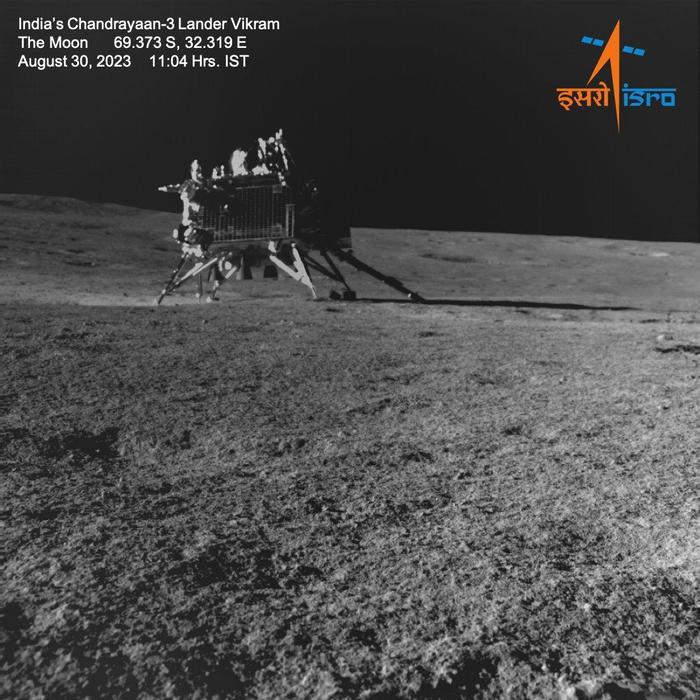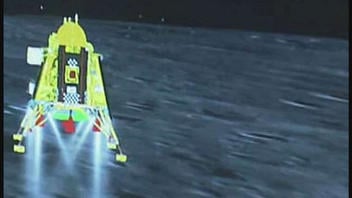
Did India fake the landing of the Chandrayaan-3 lander module on the surface of the moon, and attempt to fool the world with an animation? No, that's not true: This image does show a simulation, but it was not presented in an effort to deceive the public.
The Chandrayaan-3 lander module, named Vikram, did achieve a soft landing near the south pole of the moon on August 23, 2023. There was no camera prepositioned on the moon's surface to film the landing as it happened -- a simulation of the descent and landing was broadcast live during the actual landing. There was a "Lander Imager Camera" that did capture images of the moon's surface during the powered descent.
After landing and once the Pragyan rover was deployed, images of the Vikram lander on the moon's surface were captured by the rover's navigation camera. Several monitoring stations could detect the satellite frequency (S-Band) signal from the lunar surface.
The claim was published in a post by podcaster Stew Peters (archived here) on X, the platform formerly known as Twitter, on August 23, 2023. The post was captioned:
BREAKING: India FAKES moon landing.
This is what the post looked like on X at the time of writing: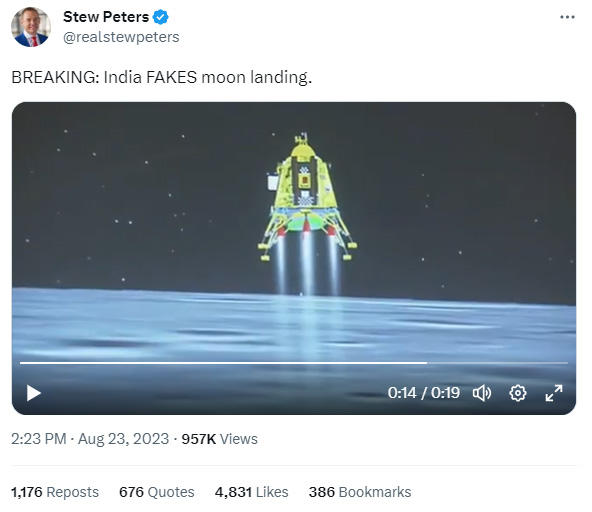
(Source: Twitter screenshot taken on Fri Sep 1 14:35:26 2023 UTC)
The Chandrayaan-3 was launched from Sriharikota, India, on July 14, 2023. On August 23, 2023, the Indian Space Research Organization (ISRO) guided the Vikram lander from Chandrayaan-3 to a soft landing near the south pole of the moon. Not all news coverage of the landing made a clearly stated disclaimer that the footage was a live simulation and not a live image of the lander, but others did. A video embedded in a BBC News article about the landing (pictured below) is captioned:
Watch a live simulation of the moment India's Chandrayaan-3 lands on the Moon
(Source: bbc.com screenshot taken on Fri Sep 01 17:56:26 2023 UTC)
The landing was livestreamed on YouTube by the official YouTube channel of the ISRO on August 23, 2023. Prime Minister of India Narendra Modi joined the telecast remotely from Johannesburg, South Africa. At 44:26 minutes into the live telecast, a split screen shows Modi on the left and the simulation of the lander on the right. At 44:47 minutes the ISRO team in the control center can be heard erupting into cheers.
At 41:52 minutes into the live telecast, the Chandrayaan-3 Lander Imager Display appears alongside the Parameters Display showing the reading for the horizontal and vertical velocity and the altitude. The imager display is a real image from a camera on the lander, but the live image refreshes slowly one frame at a time. At any given time the picture appears to be a still image.
The following day, the ISRO posted on X a coarse but slightly more flowing video of the landing as captured from the Imager Display (embedded below).
(Source: twitter.com screenshot taken on Tue Sep 05 18:41:13 2023 UTC)
On August 23, 2023, the ramp and solar panel were deployed from the lander and the Pragyan rover rolled down to the moon's surface. A photo of the Chandrayaan-3 Lander Vikram was taken by the navigation camera on the rover on August 30, 2023, (pictured below). This photo, and several other images were posted by the ISRO account on X (here, here and here).
(Source: ISRO screenshot taken on Wed August 30, 2023 11:04 Hrs, IST)
Satellites and spacecraft use a dedicated S-band frequency range between 2 and 4 gigahertz, a microwave frequency, for space-to-Earth transmissions. The S-band signals from the lander on the moon were picked up and shared on YouTube by @DF2MZ and the Satellite Tracking Channel. A company providing satellite tracking services, Von Storch Engineering, congratulated ISRO on the moon landing, posting a readout on X (embedded below) that shows the downlink (moon to Earth transmission signal):
Congratulations @isro on successfully landing on the moon! The signal spectrum below was received by our tracking station and shows a strong s-band downlink signal from the Chandrayaan-3 lander from the surface of the moon just after landing. #Chandrayaan3Landing #chandrayaan3 pic.twitter.com/j6q8tNG4qX
-- Von Storch Engineering (@vonstorcheng) August 23, 2023
Lead Stories debunked a similar claim regarding a broadcast simulation from 1969. CBS News broadcast live coverage of the Eagle's moon landing during the Apollo 11 mission on July 20, 1969, including well-marked animations depicting the module landing. While the audio feed was relayed live, including Neil Armstrong saying, "Houston, Tranquility Base here. The Eagle has landed," there was no visual image available to broadcast during the landing.

